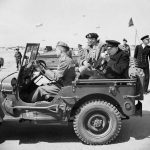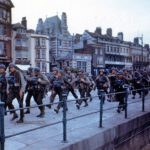John Jolliffe – Author and administrator of this website
If anyone wants to know details of the next website to come out – email me at: john.jolliffe@outlook.com unfortunately there has been a little bit of curious ‘damage’ to this site, and the email link does not work – so until I have time to find out what the problem with that is (which appears elusive) YOU WILL HAVE TO PUT THE EMAIL IN FROM YOUR OWN EMAIL ADDRESS SYSTEM, and send it that way. Please add a little bit about yourself, with your enquiry.
See also ~


* D-DAY-DORSET WILL BE HAVING A MAJOR UPGRADE, on a separate additional website (the link to it will be provided near the top of this Home Page). It will have very many different and new topics, with significant and detailed content.
~~~~~~~~~~~~~~~~~
I consider this website ~ as a basic draft.
It has acted as preparation for one that is now currently under construction ~ aiming at presenting a far more detailed version.
This is Version 1, a Draft version for the D-Day-Dorset website
This is a basic draft of D-Day-Dorset.
Another website is in production and will be ready at the end of 2023, with very much more coverage and details, regarding Dorset in World War 2, and D-Day itself.
Due to the amount of information now being collated, and the need to integrate it into an harmonious picture – this is taking longer than expected, and the material will not be ready in February as was stated earlier. It is deferred to the end of 2023.
Also – there is far too much material now gathered for a single website – so the compromise will be, that the website will still be updated and significantly added to – but the rest of the gathered material will be put into book form – comprising one or maybe two books. John Jolliffe.
PHOTOS OF REMEMBRANCE SUNDAY / VETERANS DAY/D-DAY REMEMBRANCE ~ events in Dorset, are published on the menu page ‘DORSET JOURNAL’ on this website
*see menu – at the top of this page for ‘Dorset Journal’ – or click on the following link:
https://www.d-day-dorset.uk/category/dorset-journal/
On the new website, much detail will be given on the very major game-changing developments of the Telecommunications Research Establishment ~ in regards to developments in radar that took place in The Purbecks ~ where applications of these developments were made operational for land, sea and air. The purpose of their presence in the Purbecks was surrounded by an atmosphere ~ of the utmost strict, absolute and total secrecy.
Also details are given of the already battle hardened 26th Regiment of the US 1st Infantry Division that arrived in East Dorset in 1943. The 26th Regiment were based in Swanage, where these troops at times entertained the young evacuees that were already living in Swanage, after having been evacuated for their safety from East London, at the beginning of the war.
The 26th, along with the 18th and the 16th regiments of the US 1st infantry Division ~ based in East, Central and West Dorset respectively ~ were now undergoing yet again more arduous ‘amphibious trainings’ in preparation for their next amphibious landing, which was ~ D-Day.
Their exact destination for their next amphibious landing was kept secret ~ and as yet ~ still unknown to them till the very last few days ~ where by that time they had been assembled into secure and guarded compounds ~ preparing for embarkation ~ and thus in these situations ~ successfully continuing to keep their destination ~ a complete and total secret.
Unknown to them at that time, their destination was to be Omaha Beach, Normandy, on the North Coast of France.
A time sequence of around 20 significant developments that took place in those times~ will be provided ~ from 1939 to D-day, including details of the following few days thereafter.
The new website will be about events leading up to D-Day in Dorset, with a description of D-Day itself, for the US troops that embarked from Dorset.
Proceeding this ~ will be a description and history of the beginnings and earlier developments of radar ~ on its different locations in the UK ~ before then this energy of creativity and innovation found its way to the Purbeck Hills, on the Dorset Coast. At that time and place ~ there were further central key developments, along with various crucial applications for use on land, at sea, and in the air.
This will also entail the earlier related story of the essential role of radar for the Battle of Britain which turned the tide of the war, the airmen of which, Sir Winston Churchill had said of in The House of Commons, in 1940,
“Never in the field of human conflict was so much owed by so many to so few.”
and yet too ~ with the crucial role of The Battle of Britain having ultimately prepared the way, now almost 4 years later, with an amphibious invasion ~ it became clear that
All was owed to the success of The Second Front
‘To those that landed on that crucial day ~ D-Day, June 6, 1944’.
~~~~~~~~~~~
*a link to the new website will be provided on this Home Page ~ in February 2023, or before.
~~~~~~~
PHOTOS OF REMEMBRANCE SUNDAY / VETERANS DAY/D-DAY REMEMBRANCE ~ events in Dorset, are published on the menu page ‘DORSET JOURNAL’ on this website
(see menu – at the top of this page).
…
(the Americans were a very major presence in Dorset – with more than 2,000,000 troops from the US registering in Bournemouth – primarily at The Royal Bath Hotel & The Carlton Hotel).
PART OF THE FORMING STORY OF THIS WEBSITE
*As well as the themes about Swanage and the surrounding areas – which had had such an amazing role to play in the preparations leading up to D-Day – I’m also developing a further interesting picture – about the wide ranging activities regarding the continuing and most significant developments of radar, based around Worth Matravers, ahead of D-Day.
These developments at Worth Matravers played a very major role in the ultimate success that was to be eventually brought about in World War II.
………
Virginia. Their history – along with The US 1st Infantry Division – was that of being the troops that stormed Omaha Beach, Normandy, France – on the early morning of June 6th, 1944 – the very moment of D-Day itself.
They embarked from Poole Harbour, Portland, and adjacent Quays at Weymouth ~ in Dorset.
..
In the following video, I find this true story of Charles Shay very moving.
He was a combat medic in The 16th Regiment of the US 1st Infantry Division.
The 16th Regiment were based in and around the county town of Dorchester, Dorset.
PVT CHARLES N. SHAY – US 1ST INFANTRY DIVISION – MEDIC – OMAHA BEACH https://youtu.be/Hncn2jYpRf8
……
As well as American, British and Canadian troops, and the Australian Air Force in Bournemouth and elsewhere, and of course the French & Polish – they all together as part of the the Allied Forces made their contribution to D-Day, and thereafter; and who lost so many of their lives – so that Europe could be free.
Britain had also borrowed $120,000,000,000 by 1945, to fund this, and it took 61 years for the British taxpayers to repay this absolutely phenomenal sum.
…
I HAVE BEEN FOR SOME TIME NOW RESEARCHING SOME OF THE HISTORY OF D-DAY DORSET, in the UNITED KINGDOM ~ in further preparation for a further website to be produced after this one, about D-Day Dorset – and of the many various matters that took place in this county.
I’m relating it to the modern day boundary of Dorset. The border of Dorset was expanded further to the East in 1974, which now includes Bournemouth & Christchurch. My focus here is primarily, but not solely, on the area of South Dorset, in regard to the activities and personal experiences of those concerned. This also includes the work that took place regarding some of the most significant developments in radar – in and around the area of Worth Matravers, 2 miles from Swanage, from May 1940 to May 1942, whereupon TRE (the Telecommunications Research Establishment) moved to Malvern for safety (this will be explained in the further website that is currently under construction). Radar in many ways ~ was of course ~ one of the game changers that brought about success in the war.
I am also looking into some of the stories of the spirit and courage therein those times regarding the troops, and of the goodwill of the population in amongst which these troops were stationed, and also of course, ~ the following phenomenal courage, and also the sadness and trauma, involved during those early days of the invasion ~ as regards the time period of this website coverage, and in particular preparing for the further and next website that is currently being undertaken.
The US 1st Infantry Division were first stationed in Dorset starting in January 1942,
The 26th Regiment was stationed at Swanage, from November 1943 – having come from carrying out amphibious landings in North Africa, and then Sicily.
One of their training grounds whilst in South Dorset was what could now be described as the ‘The Lost Village of Tyneham’. This village has been preserved – has just stood still in time – like a ghost village – just exactly as it was – nothing has changed – from when the very last person left on December 17, 1943.
It is so sad – that the villagers lost their village – where they and their forefathers had lived for so many generations. But there was a great purpose at hand – and I hope it doesn’t seem disrespectful to the villagers – but even sadder for the troops of the US 1st Infantry Division – who were then – because of their earlier experience in invading North Africa, and then Sicily – were then given the task of playing their never-to-be-forgotten role in the invasion of the Normandy Coast, in occupied France.
And for the 26th stationed in Swanage – destined for the infamous landing at Omaha Beach.
…
DORSET is just slightly West of central South England – it played a very major role in the preparations for D-Day – with the main embarkation points on June 6, 1944, being mainly from Poole, Weymouth and Portland in Dorset (Portland & Weymouth being contiguous with each other).
These and other embarkation points from nearly all along the South Coast of England – landed on the Normandy beaches – landing 73,000 US troops (Omaha and Utah beaches), 62,000 British troops (Sword and Gold beaches), and 21,000 troops at the Canadian sector (Juno beach), of which 14,ooo were Canadian, and 7,000 were British). The total was 156,000, along with 20,000 vehicles, landing on that first day – Tuesday, June 6, 1944 – the day of The Greatest Sea Invasion in the History of the Earth.
This was accomplished by nearly 7000 ships – battleships – destroyers – frigates, landing craft, and all and every kind of variety of other smaller vessels
14,000 sorties by 10,000 aircraft
and within 5 days, having safely then landed 54,000 military vehicles
and by the end of June, a million troops had landed in Normandy
nevertheless only 12 miles of land was gained after the first month of bitter, hard and grueling fighting
and on West side – all was being done by those that had landed at the Omaha and Utah beaches – to make their way in securing of Cherbourg Harbour, which would ultimately be needed.
There were 2 temporary Mulberry Harbours (absolutely huge artificial concrete harbours, towed across the English Channel from the south coast of England ~ one of which in fact collapsed on the American side after a many days of very severe stormy weather), but even then they would not have been enough for all that was ultimately needed for this almighty war.
and simultaneously at this point ~ all around the Normandy area ~ urgently needed airfields were to be rapidly constructed.
…………
In the UK, Bournemouth International Airport in Dorset – was originally purpose built. It was then called Hurn Airport, purpose built or rather modified with a concrete runway ~ in World War II for the needed air defence along the coast. Radar based in and around the small village of Worth Matravers, high up on the Purbeck Hills, 2 miles from Swanage – would via the system of the communication network – alert the Spitfires and other aircraft to incoming intruders – including alerting the many airfields around for these and other purposes. Hurn airport (which is its original name) – had then provided a valuable, highly efficient, and what was for that time in Dorset~ a very modern concrete runway.
Bournemouth is where very considerably more than 2,000,000 troops were registered in World War II, in the preparations for D-Day – registered mainly in one five-star hotel, and also another hotel not far away – The Carlton Hotel.
2 million American troops, had been or were stationed in England by the spring of 1944.
In the UK as a whole – these military divisions were as follows:
US (20 Divisions), British (14 Divisions) and Canadian (3 Divisions)) – with French and Polish having one Division each.
You will find fairly regular posts of varying everyday general interest in the section ‘Dorset Journal’
… such as WWII military vehicles that occasionally park up at Viewpoint on a Sunday – Viewpoint overlooks Poole Harbour (where a vast array of D-Day assault landing craft left from on D-Day) – also in this section there are old pictures of Dorset in the early 1940s – and photos taken in 2018 onwards, of the 29th Infantry Division re-enactment, which often exhibit in Dorset, in current times.
*See latest post in Dorset – April 4, 2019
…
‘ONE OF THE REMAINING ARMY RANGERS TO STORM THE SHORES OF NORMANDY’
the above is a short video – about The Rangers on D-Day – and later back in the US – although – this video doesn’t describe the actual details of what was in fact the truly awe-inspiring courage of those men on that day… who ran up the beaches and then scaled the vertical cliffs – at dawn on 6 June 1944…
……
My interest first began regarding D-Day Dorset – after hearing true stories related to me about the trauma that some soldiers had experienced at that time – who had left from the coast of Dorset.
This led me to discovering further the absolutely phenomenal – almost unbelievable story that it all was – and what an amazing role – and in a number of ways ~ a central role ~ that Dorset had in all this.
This will be seen in my further writings.
Viewpoint – in Poole – overlooks the historic Poole Harbour – with its Brownsea Island in the middle – was where vast numbers of craft and assault landing craft (LCA’s – Landing Craft Assault) – around 500 in fact – left in the early hours of Tuesday, June 6, 1944 – to land on the beaches of Normandy.
At Viewpoint, there was also an anti-aircraft gun with searchlight operating during WW2, not far from where the kiosk for food and drinks stands now.
……………..
There were of course absolutely vast preparations for D-Day, all over the UK as a whole.
But this website’s focus is on D-Day in Dorset – with the date of D-Day being Tuesday, June 6, 1944.
This story ~ will he continued in the next much further developed website that is currently in construction ~ covering the whole period from September 3, 1939 to May 8, 1945 (beginning and end times of World War II in Europe, for the UK) .
There have been a vast number of stories, books, videos and films – of this period, of course.
~~~~~~~~~~~~~~~~~
Please see the CONTACT section
No piece of information is too small – even just a comment about a ration book – it all contributes to the picture – and we need this information before it is lost forever.
As I think many people will realise, who have been looking into this period – there is an absolutely vast amount of information to be read and seen – about what really happened. What I gather from looking into this – is that the details are almost endless – *yet still so many stories are not known – have never been heard before.
This is partly because of the extreme level of secrecy that was operating during that time. A level of secrecy – that will take one by surprise when one looks into it. So secret – that some things have only recently been found out – that were in fact at the time major factors of the war.
And also partly – that people’s personal experiences – were just as it says – they were personal – and only they knew about them – or the relatives that they told – or as noted in journals that a few had made.
Many thanks – John Jolliffe – MA, MBC-PG Dip. (UKCP – retired 2014)
